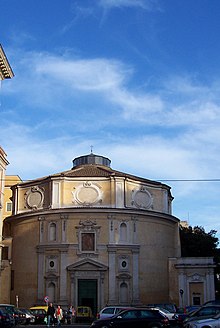S. Bernardo alle Terme
| San Bernardo alle Terme St. Bernard at the baths (in English) Sancti Bernardi ad Thermas (in Latin) |
|
|---|---|

Façade of San Bernardo
|
|
| Basic information | |
| Location |
|
| Affiliation | Roman Catholic |
| District | Lazio |
| Province | Rome |
| Country | Italy |
| Ecclesiastical or organizational status | Titular church |
| Leadership | George Mar Alencherry |
| Architectural description | |
| Architectural type | Church |
| Groundbreaking | 1598 |
San Bernardo alle Terme is an abbatial church in Rome, Italy.
The church was built in 1598 and was initially given to a French Cistercian group, the Feuillants, through the intercession of Caterina Sforza di Santafiora. Later, after the dissolution of the Feuillants during the French Revolution, the edifice and the annexed monastery were ceded to the Congregation of St. Bernard of Clairvaux, after whom the church is named.
The German painter Johann Friedrich Overbeck, founder of the Nazarene art movement, is buried here. The current Cardinal Priest of the Titulus S. Bernardi ad Thermas is George Mar Alencherry.
The structure of San Bernardo alle Terme is similar to the Pantheon, since it is cylindrical, with a dome and an oculus. The edifice has a diameter of 22 meters. The dome decoration, made of octagonal coffers, reminds that of the Basilica of Maxentius. The interior is graced by eight statues of saints, each housed in wall niches, the work (c. 1600) of Camillo Mariani. These are a good example of the so-called International Mannerism. The Chapel of St Francis is an addition to the ancient rotunda, and contains a sculpture of St Francis by Giacomo Antonio Fancelli. The construction of the church recycled the remains of one of only two circular towers, which marked the corners the southwestern face of the perimeter wall around the Baths of Diocletian, the other tower is today part of a hotel building and lies 225 meters southeast from San Bernardo alle Terme. Between these two tower-like structures, also part of the same perimeter wall, there used to exist large semicircular recess, similar to an exedra, which was probably used as a sphaeristerium. Nowadays, the enormous scale of this recess and that of the wall itself may only be imagined from the layout of the modern Piazza della Repubblica, which followed the original layout of the ancient wall.
...
Wikipedia
